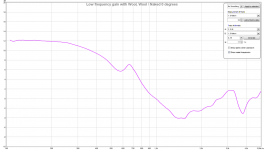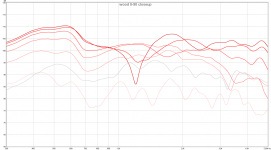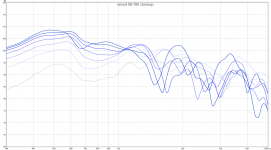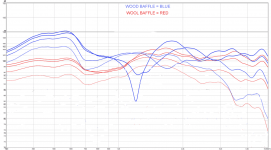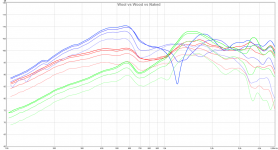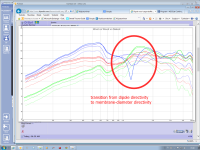It does look very similar to what troels is using yes =) Cabinet-damping
And I got them from here: Filtmatta 2 m - Ljudia - Multimedia Hemelektronik Karaoke PA anläggning DJ utrustning Ljus utrustning
Really cheap too, a gigantic roll of 2x1 m for 99 kr each so I bought 5 of them =)
And I got them from here: Filtmatta 2 m - Ljudia - Multimedia Hemelektronik Karaoke PA anläggning DJ utrustning Ljus utrustning
Really cheap too, a gigantic roll of 2x1 m for 99 kr each so I bought 5 of them =)
Attachments
Here we have Naked 0 measurement / Wool 0 measurement which if I'm not mistaken shows the low frequency gain, for science! 😉
It does seem to correlate with the invisible dipole peak at about 233 hz since there is no significant additional gain below that.
Kinda cool to trade low frequency gain for dipole peak gain. After I've got some food in my stomach I'll probably start building that hard baffle.
It does seem to correlate with the invisible dipole peak at about 233 hz since there is no significant additional gain below that.
Kinda cool to trade low frequency gain for dipole peak gain. After I've got some food in my stomach I'll probably start building that hard baffle.
Attachments
 Wood vs Wool baffle will tell us a lot. Very much looking forward to it. Be careful to make your wood baffle exactly the same size and shape, so that we get the best comparison.
Wood vs Wool baffle will tell us a lot. Very much looking forward to it. Be careful to make your wood baffle exactly the same size and shape, so that we get the best comparison.You asked and so here it is!
And brace yourselves, it is ugly! 😉
Measures as expected, kinda nice up until about 700 hz and then it falls apart, a far cry from the smoothness of the wool baffle. The rear dispersion even falls apart before that in the on axis.
I think I measured from the same distance and if so it seems that pure wood is a bit more efficient down low, which isn't that unexpected. Would be interesting to know if having a thicker wool baffle would lessen this advantage too =)
All in all I'd say it is likely that wool is a very good material to make dipole baffles out of.
I think wool baffle is primarily an advantage of 300 and upwards since the lower frequencies low through damping too easily. It does simplify and reduce excursion needs on the the drivers at ~ 300 and upwards massively though. An interesting idea I want to test is to make a H-frame for the 100-300 woofer out of wool, if I guess correctly I could make it bigger than I could out of wood to compensate for the efficiency loss and say I use twice the layers of wool... if it worked then I could probably simplify my crossovers and stick with 12 dB / oct instead of 24 dB which would be nice.
Lastly, a minor but also interesting detail is that baffle vibrations become a moot point with a wool baffle =)
And brace yourselves, it is ugly! 😉
Measures as expected, kinda nice up until about 700 hz and then it falls apart, a far cry from the smoothness of the wool baffle. The rear dispersion even falls apart before that in the on axis.
I think I measured from the same distance and if so it seems that pure wood is a bit more efficient down low, which isn't that unexpected. Would be interesting to know if having a thicker wool baffle would lessen this advantage too =)
All in all I'd say it is likely that wool is a very good material to make dipole baffles out of.
I think wool baffle is primarily an advantage of 300 and upwards since the lower frequencies low through damping too easily. It does simplify and reduce excursion needs on the the drivers at ~ 300 and upwards massively though. An interesting idea I want to test is to make a H-frame for the 100-300 woofer out of wool, if I guess correctly I could make it bigger than I could out of wood to compensate for the efficiency loss and say I use twice the layers of wool... if it worked then I could probably simplify my crossovers and stick with 12 dB / oct instead of 24 dB which would be nice.
Lastly, a minor but also interesting detail is that baffle vibrations become a moot point with a wool baffle =)
Attachments
Last edited:
If we were to perforate the edges of the hard baffle so that it more closely matched the characteristics of the wool pad baffle it would be similar. Tho doubtful as good. Using both and adding a fatter rounded edge akin to JMMLC horn profile would help with diffraction. When using acoustically absorbent material should be and must be looked at in the physical shape and the acoustical shape due to the varying permeability of the material at various wavelengths.
In another thread we were discussing this aspect, Dr. Geddes has pointed this edge thickness factor in OB design causing diffration related issues and I agree with his conclusions, yet expand upon it from personal experience.
If we are wrong I would really like to know. No point in spreading nonsense. Great tests for sure, keep up the excellent work OllBoll 🙂
In another thread we were discussing this aspect, Dr. Geddes has pointed this edge thickness factor in OB design causing diffration related issues and I agree with his conclusions, yet expand upon it from personal experience.
If we are wrong I would really like to know. No point in spreading nonsense. Great tests for sure, keep up the excellent work OllBoll 🙂
Great work, thanks!
I've done an overlay of wood vs wool with just 4 traces each for clarity. The graphs have been resized to match on the X and Y axis. It seems that the wool does not have the low end gain that wood has, but wool has a much flatter response.
What do you think?
I've done an overlay of wood vs wool with just 4 traces each for clarity. The graphs have been resized to match on the X and Y axis. It seems that the wool does not have the low end gain that wood has, but wool has a much flatter response.
What do you think?
Attachments
Great work, thanks!
I've done an overlay of wood vs wool with just 4 traces each for clarity. The graphs have been resized to match on the X and Y axis. It seems that the wool does not have the low end gain that wood has, but wool has a much flatter response.
What do you think?
( blue is wood, red is wool, green is naked )
Seems about right, an interesting thing though is that it is only over 300 that there is a significant gain difference, if we watch from 100 it is almost the same with wool and wood. Especially when you put the naked baffle into perspective.
I might as well throw up all the raw data. I hoped that compressing them would make them smaller but the files are still pretty big : /
When looking at impulse as far as I can see they are basically the same except that naked has more noise... but that is probably because I forgot to turn off the pond fountain that was a few meters away when measuring =)
Attachments
Last edited:
Thanks for the raw data, great to get that. What software did you use for the measurements? The files look to be MATLAB types.
Thanks for the raw data, great to get that. What software did you use for the measurements? The files look to be MATLAB types.
I used REW.
Thank you for doing this experiment and sharing the measurements!
An other thing - have you experimented with different thickness of the wool baffle?
An other thing - have you experimented with different thickness of the wool baffle?
An other thing - have you experimented with different thickness of the wool baffle?
Nope, have only tested with 3 sheets.
It would also be interesting to see what comes out of ply baffle covered with wool on both sides. Great job, OllBoll.
Interesting!
To me these measurements prove that with open baffles we can't overcome the transition zone. In the range below dipole null, dipole function determins directivity. At even higher frequencies driver-membrane diameter determines dipectivity. Between these we have the uncomfrortable transition zone where both response and directivity wobble and wiggle.
To me these measurements prove that with open baffles we can't overcome the transition zone. In the range below dipole null, dipole function determins directivity. At even higher frequencies driver-membrane diameter determines dipectivity. Between these we have the uncomfrortable transition zone where both response and directivity wobble and wiggle.
Attachments
It would also be interesting to see what comes out of ply baffle covered with wool on both sides. Great job, OllBoll.
+1! maybe would be also worth trying a heavy mass loaded vinyle or EPDM membrane, covered with wool.. just a thought..
- Status
- Not open for further replies.
- Home
- Loudspeakers
- Multi-Way
- Dipole wool carpet baffle experiment

